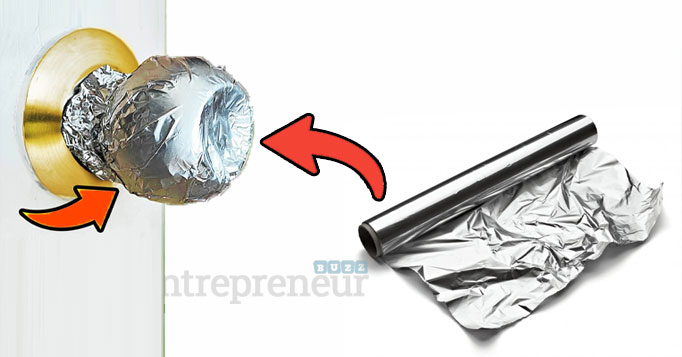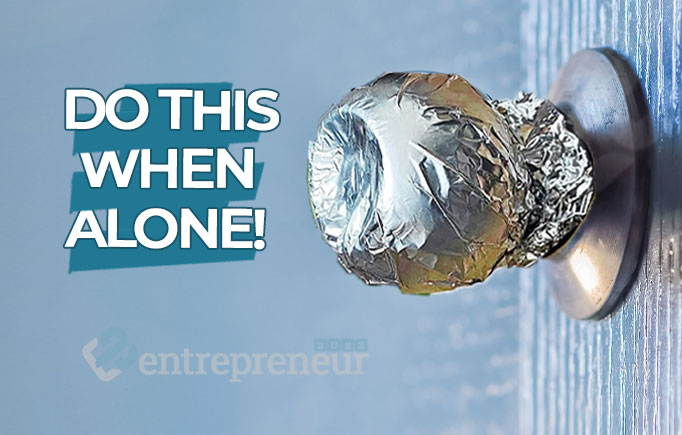Many people have heard of the tactic of wrapping aluminum foil around a door knob when they are alone, but few know the reasoning behind it. If you live alone and someone tries to break into a home with a lock pick, the foil will make it hard to open your door for the intruder to gain entry. This is because the foil will bend and make noise, alerting the person inside to the attempted break-in.
Additionally, aluminum foil has the potential to interfere with the lock-picking tools, making them less effective. While it is not a foolproof method of ensuring safety, it can provide extra protection when a person feels vulnerable. It is always important to take necessary precautions to protect oneself, and wrapping a door handle alone is a simple and easy way to do so.
What is the purpose of wrapping aluminum around a doorknob?
Wrapping aluminum foil around a doorknob serves several purposes. First and foremost, it can act as a makeshift insulator to prevent cold air from seeping through the cracks around the door. Additionally, it can prevent burglars to break from entering a home by making it difficult to turn the doorknob or leaving visible evidence of tampering. In some cases, foil around a metal lever can also help protect against static electricity, which can be particularly useful for individuals working with sensitive electronics. Finally, wrapping foil around a doorknob can be a fun and creative way to add a unique decorative touch to a room or home. For safety reasons, wrapping a doorknob can be useful in various situations.

Using foil as a security measure to deter burglars
Using foil as a security measure to deter burglars is a cheap and easy way to make your home less attractive to thieves. While it may seem unconventional, placing aluminum foil on windows or sliding glass doors can create a mirrored effect that makes it difficult for anyone to see inside. This makes it hard for them to determine whether anyone is home or if there is anything worth stealing. The shiny surface may also deter would-be burglars who prefer to remain unnoticed. While foil alone may not be enough to secure your home completely, it can add more protection to existing security measures. Plus, it is a cost-effective option for homeowners on a budget who want to improve their home security. Using deadbolt locks as a security measure is a simple and low-cost way to protect your home and keep you safe.
Making it more difficult for intruders to enter your home
There are various ways to make it much harder for intruders and ensure the safety of your family and belongings. First and foremost, invest in a sturdy and durable front door made of solid materials such as steel or hardwood. Install deadbolts and high-security locks with reinforced strike plates on all doors and windows. Consider fitting motion-activated outdoor lights and CCTV cameras to deter potential burglars. Keep your yard tidy and trim bushes and hedges to remove potential hiding places. Utilize smart home technologies such as smart locks, doorbells, and security systems that can alert you and the authorities in case of any unusual activities. By taking these steps, you can add a layer of protection to your home and discourage unwanted visitors from entering.
Can foil keep me safe when I am alone?
Foil a doorknob is unlikely to provide substantial safety when you’re alone. While it may create a minor deterrent or noise if someone tries to turn the doorknob, it’s not a reliable or effective security measure.
How can I wrap the doorknob with foil, and what materials do I need?
To wrap your doorknob with foil, you’ll need a few materials:
- Aluminum foil: This is the main material to foil around the doorknob. Aluminum foil is easily available at grocery stores or supermarkets.
- Scissors: You’ll need a pair of scissors to cut a piece of aluminum foil into the appropriate size and shape.
- Tape (optional): You can use tape to secure the foil around your door knob. It helps to prevent the foil from unraveling or slipping off the door knob.
Can a rubber band be used instead of foil?
While foil is commonly used to cover doorknobs and hardware to avoid leaving fingerprints or to create a barrier, a rubber band can serve a similar purpose; wrapping a tin foil on your door knob can provide a protective layer and help prevent direct contact with the knob. This can be particularly useful when you want to avoid leaving fingerprints or are concerned about hygiene. So, while it can be a makeshift solution, it’s not a perfect replacement for foil in all scenarios.
How does wrapping a latch with foil work?
Wrapping your doorknob in aluminum foil creates a physical barrier that makes it impossible for intruders to grip and turn the knob. It’s a simple, inexpensive way to protect a deterrent that adds an extra layer of security to your home.
Grip and turn the doorknob
Grip and turning the lever can be done by using a simple household item: aluminum foil. By covering aluminum foil on the door on your doorknob, you create a barrier that adds friction and makes it more difficult for someone to grip and turn the knob. This can deter burglars and enhance the security of your home, especially when you’re alone or away. Foil is an easy way to wrap around the door’s liver and secure it while you’re away. Additionally, installing deadbolt locks and using a security system are recommended to keep your home safe and secure.
Preventing someone from opening the door by covering the lock
Here are a few simple tricks to consider:
- Tin foil around the doorknob creates an entire surface smoother, stopping burglars to grip and turn.
- Cover the door bulge tight and secure enough to cover the door frame with foil to increase the surface area to make it harder for someone tries to enter.
- Use enough foil to cover the entire knob: Ensure that the foil completely wraps around the doorknob, leaving no exposed areas. This will eliminate any potential grip points and increase the effectiveness of the deterrent.
- Secure the foil tightly: Ensure the foil around your doorknob is wrapped tightly to prevent easy removal. The tighter the foil on door, the harder it will be for burglars to use a credit card to open the door latch when you’re home alone.
When is it appropriate to wrap a doorknob using aluminum?
Wrap your door knob can be useful to protect yourself from unwanted germs and bacteria. This technique has become quite common in public places where doorknobs are frequently used. It is commonly used for hospitals, schools, and other public entrances. If you are sick or handling dirty items, it is recommended to wrap around the door knob to avoid spreading your germs. It’s also useful for preventing transmission of contagious diseases in any public place.
Wrapping the doorknob can also be an effective home hygiene technique to protect you from burglars that might accumulate on door knobs. Lastly, while it is recommended to sanitize/ clean door knobs, Covering a foil can provide an extra layer of protection and help maintain cleanliness. People believe It’s important to note that it’s not always necessary to wrap tin foil around, but it’s appropriate when hygiene/ cleanliness is paramount.
When you are home alone and want to feel more secure
When you are home alone and want to feel more secure, there are several steps you can take to ease your mind. One of the most important things to do is to ensure that all doors and windows are locked. This will prevent any unwanted from entering your home. You may also want to consider investing in a security system or a smart home device to monitor your home remotely. Another way to deter burglars and feel more secure is to keep a phone close in an emergency. It’s important to have a plan in case of a break-in or other emergency.
Additionally, keeping some lights on inside and outside your home can create the impression that someone is home. Finally, try to keep the volume of any electronic appliances or music down so that you can hear any potential disturbances. These steps will help you feel more secure and give you peace of mind while home alone.
When you are away from home and want to give the impression that someone is home:
- Use timers for lights, TV, or radio to create the illusion of activity.
- Ask a neighbor to collect or hold your mail by the post office.
- Use smart home devices to control lights or appliances remotely.
- Keep curtains or blinds partially open to make it appear as though someone is inside.
When you live in a high-crime area and want to take extra precautions:
- Install a security system with cameras and alarms.
- Reinforce doors and windows with sturdy locks and shatter-resistant glass.
- Use motion-activated outdoor lighting to stop thieves.
- Form a neighborhood watch program to increase community safety.
Can you use foil on other door parts?
While wrapping foil can be used on door knobs to make it more challenging for burglars to grip the door, it’s not common to use foil on other door parts. Foil may not provide significant deterrent value when applied to other areas, such as the door frame or lock mechanism.
Are there any potential dangers to using foil in this way?
There are no inherent dangers to using foil as a temporary security measure. However, it’s important to remember that foil alone is not a foolproof method to prevent break-ins. It may deter opportunistic burglars but could be bypassed by more determined trespassers. It’s important to prioritize comprehensive security measures for enhanced home protection.
What are the alternatives to wrapping aluminum on a door knob?
- Doorstop or door wedge: Use a doorstop or wedge to create an obstacle for someone to unlock their way through a closed door.
- Security system or additional locks: Install a security system with cameras, motion sensors, and alarms, or add locks like deadbolts for increased resistance against forced entry.
- Dog as a pet: Keep a dog to benefit from their keen senses and instinct to alert you to a potential housebreaker.
- Surveillance stickers or signs: Display stickers or signs indicating the presence of surveillance cameras to create the perception of heightened security.
Also read: Dwarf Fortress Aluminum
Are there any other uses for aluminum foil for home security?
Additional uses for foil in home security to feel safe:
- Window privacy: Apply foil to windows to prevent outsiders from seeing inside your home, enhancing your privacy and deterring potential intruders.
- Motion sensor enhancement: Boost motion sensors’ range and accuracy by placing foil strips near the sensors, reflecting their signals effectively.
- DIY alarm system: Create a simple alarm system by attaching foil to doors or windows. When the foil is disturbed, it breaks the circuit and triggers an alarm, alerting you to unauthorized entry attempts.
- Valuables concealment: Wrap valuable items in aluminium foil to shield them from RFID scanners or thermal detection, making it harder for thieves to locate them.
Remember, while foil can offer some added security, it should be used with other real security measures for optimal protection.

